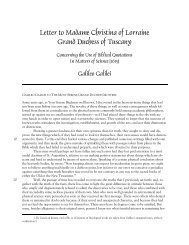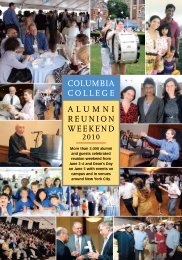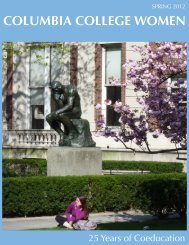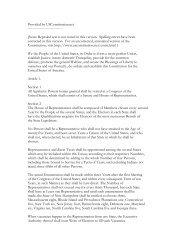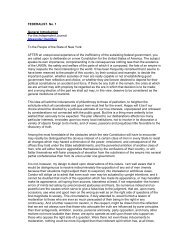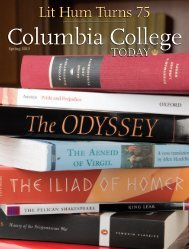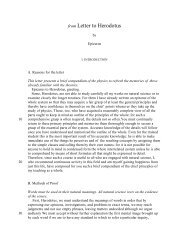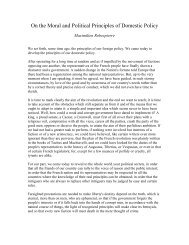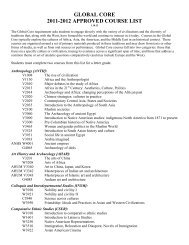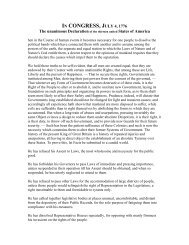Download this issue as a PDF - Columbia College - Columbia ...
Download this issue as a PDF - Columbia College - Columbia ...
Download this issue as a PDF - Columbia College - Columbia ...
You also want an ePaper? Increase the reach of your titles
YUMPU automatically turns print PDFs into web optimized ePapers that Google loves.
CLASS NOTES<br />
COLUMBIA COLLEGE TODAY<br />
COLUMBIA COLLEGE TODAY<br />
CLASS NOTES<br />
Robert Shlaer ’63 Recreates<br />
History Through Daguerreotype<br />
Though he w<strong>as</strong> born<br />
and educated on the<br />
E<strong>as</strong>t Co<strong>as</strong>t, Robert<br />
Shlaer ’63, ’66 GSAS<br />
is a westerner at heart. Sure,<br />
he looks the part, with his thick<br />
beard, flannel shirt and suspenders,<br />
but it runs deeper than<br />
that. Shlaer is a westerner in<br />
that older, more romantic sense<br />
of the word: He’s an individualist,<br />
determined to carve out his<br />
own path wherever it may lead.<br />
And sometimes it leads to<br />
someone else’s path. For nearly<br />
two decades, Shlaer h<strong>as</strong> been<br />
exploring America’s western<br />
landscape with a camera in tow,<br />
retracing the steps of the great<br />
explorers of centuries p<strong>as</strong>t. He<br />
B y Justin DeFreita s<br />
h<strong>as</strong> sought both to recreate and<br />
expand on the work of the pioneering<br />
artists and daguer re otype<br />
photographers who documented<br />
these 19th-century expeditions,<br />
capturing the same vist<strong>as</strong> that<br />
were once framed in the viewfinders<br />
of his predecessors.<br />
Shlaer considers daguerreotype<br />
— the silvery images that<br />
reigned from 1839–60 <strong>as</strong> the<br />
first commercially viable form of<br />
photography — to be “the most<br />
beautiful of all forms of photography.”<br />
But it’s hardly the most<br />
reliable. “My first and greatest<br />
love remains the landscape,” he<br />
says, “so with a process <strong>as</strong> given<br />
to failure <strong>as</strong> daguerreotypy, it<br />
is comforting to know that the<br />
Self-portrait in Cathedral Valley, Capitol Reef National Park, Utah, May 1998.<br />
subject will be there tomorrow<br />
for another try.”<br />
Shlaer w<strong>as</strong> born in Manhattan<br />
and raised in New Mexico,<br />
where his father, Simon Shlaer<br />
’24, ’37 GSAS, w<strong>as</strong> an engineer<br />
at Los Alamos National Laboratory.<br />
By Shlaer’s own admission,<br />
his academic career w<strong>as</strong> an<br />
exercise in expedience. Though<br />
his family put a premium on<br />
education, Shlaer applied to the<br />
<strong>College</strong> more because it made<br />
its admissions decisions earlier<br />
than other schools. “I figured<br />
that if I got accepted, I wouldn’t<br />
have to put any effort into applying<br />
elsewhere,” he says.<br />
He started out studying physics<br />
but became disenchanted<br />
and made a late switch to art<br />
history, primarily because it w<strong>as</strong><br />
the only degree that could be<br />
completed in two years. Later,<br />
he pursued a m<strong>as</strong>ter’s in experimental<br />
psychology at <strong>Columbia</strong><br />
in part, he says, <strong>as</strong> a means of<br />
avoiding the draft, then moved<br />
on to thesis work in neurophysiology<br />
at Rochester before earning<br />
a Ph.D. in neurophysiology<br />
and sensory psychology from<br />
Chicago in 1971.<br />
For a few years Shlaer continued<br />
in academia, working <strong>as</strong><br />
a researcher and lecturer in the<br />
Department of Neurosurgery at<br />
Northwestern University Medical<br />
School, but he struggled<br />
with the desire for a different<br />
career. It w<strong>as</strong> an “escapist<br />
fant<strong>as</strong>y” that had crystallized<br />
during his tenure<br />
at <strong>Columbia</strong>, when he<br />
had seen an exhibit of<br />
works by Ansel Adams at<br />
the Museum of Modern<br />
Art. Adams’ imagery invoked<br />
a longing in Shlaer<br />
to wander and document<br />
the western landscape.<br />
In the mid-1970s, newly<br />
inspired by a quote from<br />
Adams in which he declared<br />
the daguerreotype<br />
the benchmark against<br />
which he me<strong>as</strong>ured his<br />
own creations, Shlaer<br />
decided to take up the<br />
moribund medium.<br />
Shlaer immersed himself<br />
in the craft, embarking<br />
on a project of selfeducation.<br />
He ordered<br />
customized plates from<br />
a commercial manufacturer<br />
and hand-built the<br />
necessary equipment for<br />
preparing and developing<br />
them and for handling<br />
the toxic chemicals the<br />
process requires. (In<br />
daguerreotypy, an image<br />
is captured on a polished<br />
and chemically treated<br />
layer of silver atop a<br />
copper plate and must be<br />
developed in short order<br />
by exposing the plate to<br />
mercury vapors.) After<br />
six months of refining his<br />
technique, Shlaer left his<br />
academic life behind and<br />
returned to New Mexico,<br />
determined to make his<br />
living <strong>as</strong> a daguerreotypist.<br />
He quickly realized,<br />
however, that he didn’t<br />
have the money or the<br />
facilities to get his new<br />
career off the ground.<br />
What followed w<strong>as</strong> an<br />
extended period of peripatetic<br />
employment that<br />
included tutoring at St.<br />
John’s <strong>College</strong> in Santa Fe<br />
<strong>as</strong> well <strong>as</strong> an eight-year<br />
stint crafting and selling<br />
custom woodwind instruments.<br />
By the mid-1980s Shlaer<br />
finally felt that he had everything<br />
he needed to make<br />
a go of it. He promoted<br />
himself <strong>as</strong> “The World’s<br />
Only Full-Time Professional<br />
Daguerreotypist” and sold<br />
his work in local galleries<br />
before beginning the project<br />
that would become<br />
his magnum opus: the<br />
recreation of the lost daguerreotypes<br />
of Solomon Nunes<br />
Carvalho, the young photographer<br />
hired by famed explorer<br />
John C. Frémont to document<br />
his final expedition, in 1853, in<br />
search of a viable central route<br />
for a transcontinental railroad.<br />
Though Carvalho’s plates<br />
were lost in a warehouse fire in<br />
1881, many of his images had<br />
been copied by engravers for<br />
use <strong>as</strong> illustrations in a book<br />
Frémont w<strong>as</strong> planning. Shlaer<br />
w<strong>as</strong> intrigued by the idea of<br />
recreating them in their original<br />
form, a project that combined<br />
all of his talents and p<strong>as</strong>sions:<br />
the delicate daguerreotyping<br />
process called upon his scientific<br />
and technical skills, the<br />
photography itself summoned<br />
the artist in him and the exacting<br />
research not only made use<br />
of his art history background<br />
but also provided an outlet for<br />
his admittedly obsessive nature.<br />
Shlaer outfitted his minivan<br />
<strong>as</strong> a mobile laboratory and<br />
Wetterhorn Peak, Colo., from the Forks of the Cimarron River, July 1996.<br />
PHOTOS: ROBERT SHLAER ’63, ’66 GSAS<br />
began retracing Frémont’s<br />
route, tracking down every site<br />
that Carvalho photographed.<br />
“I w<strong>as</strong> able to find all of the<br />
scenes in the engravings and<br />
redaguerreotype them,” Shlaer<br />
says. “I filled in the rest of<br />
the expedition from surviving<br />
written descriptions, from my<br />
knowledge of the route and<br />
from my imagination, which I<br />
attempted to synchronize with<br />
that of Frémont and Carvalho.”<br />
“Bob’s a remarkable person,”<br />
says John Morton, a retired<br />
chemistry professor from Western<br />
New Mexico University and<br />
longtime friend of Shlaer. Morton<br />
is himself a photographer,<br />
his interest having begun with<br />
his study of old photographic<br />
processes. But Morton h<strong>as</strong><br />
never attempted daguerreotypy.<br />
“Too rich for my blood,” he says.<br />
“It’s very expensive and very<br />
difficult.”<br />
Morton testifies to Shlaer’s<br />
perfectionism. “If a daguerreotype<br />
turns out poorly he’ll wipe<br />
it off the plate,” Morton says.<br />
“I’ve seen him wipe away images<br />
I would have been proud to<br />
have caught.”<br />
Shlaer explains himself differently.<br />
“I lack self-discipline,” he<br />
says, arguing that the singleminded<br />
focus with which he<br />
pursues his p<strong>as</strong>sions is more<br />
vice than virtue. “It’s just another<br />
form of excess.”<br />
Shlaer’s “excess” resulted<br />
in a book, Sights Once Seen:<br />
Daguerreotyping Frémont’s L<strong>as</strong>t<br />
Expedition Through the Rockies,<br />
which recreates Carvalho’s lost<br />
imagery and provides a lucid<br />
and thoroughly researched account<br />
of Frémont’s expedition,<br />
correcting the historical record<br />
of a journey that had generated<br />
much myth and misinformation<br />
during the preceding century<br />
and a half. Shlaer spent four<br />
years researching the expedition<br />
in archives across the<br />
country and photographing the<br />
images out west. He spent another<br />
year writing the book and<br />
preparing a museum exhibition<br />
that traveled the country for<br />
five years. “It w<strong>as</strong> the culmination<br />
of my career,” Shlaer says.<br />
But he’s not finished. His<br />
current project h<strong>as</strong> him photographing<br />
another western trek,<br />
that of topographic sketch artist<br />
Richard Kern, who created the<br />
first visual documentation of<br />
the Rocky Mountains <strong>as</strong> part of<br />
the Gunnison Expedition, which<br />
also took place in 1853. Shlaer<br />
is using conventional photography<br />
<strong>this</strong> time, and the result<br />
will be another book, <strong>this</strong> one<br />
due in 2013. “When <strong>as</strong>ked my<br />
occupation, I now call myself<br />
a ‘visual historian of western<br />
exploration,’” Shlaer says. “And<br />
if pressed further I add, ‘specializing<br />
in the year 1853.’”<br />
To see more photographs by<br />
Shlaer, go to Web Extr<strong>as</strong> at<br />
college.columbia.edu/cct.<br />
Justin DeFreit<strong>as</strong> is a Bay Area<br />
writer, editor and cartoonist.<br />
FALL 2012<br />
70<br />
FALL 2012<br />
71




